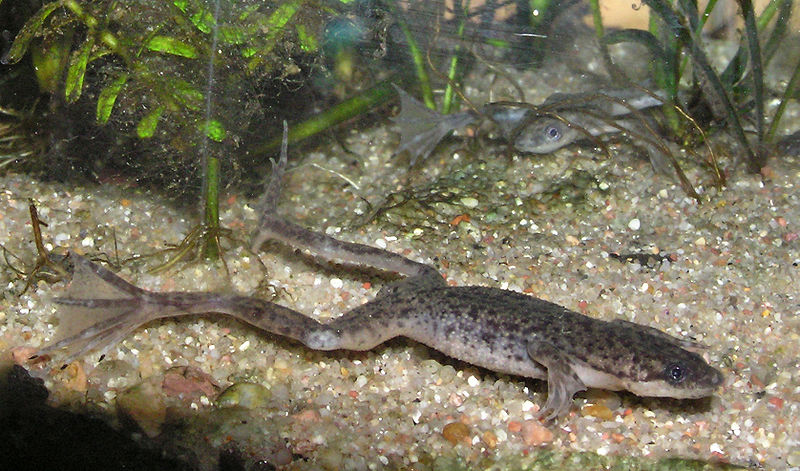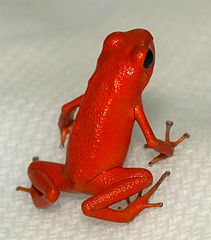For as long as I can recall, distinguishing between young African clawed frogs (Xenopus laevis) and adult dwarf clawed frogs (Hymenochirus boettgeri or H. curtipes) has been problematical for many frog keepers (and pet store employees!). The question is more than academic, because both are exceedingly common and popular in the pet trade, and their care differs radically.
Distinguishing the Species
 Both are members of the frog family Pipidae, a group of 32 species of aquatic, tongue-less and thoroughly engaging creatures. Included the Pipidae is the bizarre, back-brooding Surinam toad (Pipa pipa) and its 5 relatives.
Both are members of the frog family Pipidae, a group of 32 species of aquatic, tongue-less and thoroughly engaging creatures. Included the Pipidae is the bizarre, back-brooding Surinam toad (Pipa pipa) and its 5 relatives.
The two can be easily distinguished by closely examining the front feet. If the fingers are webbed, then the frog is a dwarf clawed frog. If they are not webbed, then it is a baby African clawed frog. Both have webbed feet.
There are subtle differences as well – dwarf frogs are even more flattened in shape than their larger cousins, and have somewhat pointed (as opposed the African clawed frog’s rounded) heads.
Lifestyle and Care Differences
African clawed frogs are boisterous, hardy beasts that eat most anything, prepared foods included, and are easily trained to feed from the hand. Captive longevity approaches 30 years.
Dwarf clawed frogs are live food specialists. Tiny and slow moving, they incessantly search the substrate for worms and other invertebrates, and do best in warm, densely-planted aquariums. A breeding group makes for an enchanting display.
Frogs and Fish?
 Unfortunately, both are often sold as “oddities” for tropical fish aquariums. This situation rarely works out…African clawed frogs consume all but the largest of fishes, and dwarf frogs are inevitably out-competed for food and perish in short order.
Unfortunately, both are often sold as “oddities” for tropical fish aquariums. This situation rarely works out…African clawed frogs consume all but the largest of fishes, and dwarf frogs are inevitably out-competed for food and perish in short order.
There are major differences in the care of both species, which I’ll cover in detail in the future. Until then, please write in with your questions and comments. Thanks, Frank Indiviglio.
Further Reading
I’ve long been fascinated by aquatic frogs, and have bred a number of species. Please see my article African Clawed Frog Behavior for some unusual observations upon which I’m seeking the comments of other frog enthusiasts.
Both frogs can be bred in captivity, and their tadpoles have a most unusual feeding strategy. For more information and a video clip, please see Suction Feeding in H. boettgeri.
Dwarf Clawed Frog Image referenced from Wikipedia and originally posted by Mwatro
 That Reptile Blog – Reptile, Amphibian and Exotic Pet Care and Information
That Reptile Blog – Reptile, Amphibian and Exotic Pet Care and Information



Dear Frank,
I am a Pipidae family breeder and I’d like to know if is there anybody who breeds Pipa carvalhoi.
Yours,
António de Sousa
Hello Antonio, Frank Indiviglio here.
Thanks for your interest in our blog. I’ve emailed a few contacts who may have done so in the past. I have your email and will let you know if I hear anything.
Good luck and please keep me posted.
Best regards, Frank Indiviglio.
Dear Frank,
thank you for your kindness.
Yours,
António de Sousa
Hello Antonio, Frank Indiviglio here.
My pleasure; they are not common in the trade, but I’ll keep my eyes open,
Good luck and please keep me posted.
Best regards, Frank Indiviglio.
Well, well, well, have already news from P.carvalhoi? I am strongly interested in contact some guys…
bye, bye
joia
Hello Joia, Frank Indiviglio here.
Thanks for your interest in our blog. I have several messages out but so far no P. carvalhoi available…I’ll be in touch if I hear anything.
Good luck and please keep me posted.
Best regards, Frank Indiviglio.
My african clawed frog is almost 13. I got her or my third birthday. She lives in a tank in my bathroom and has thrived for years. My mother finally got sick of her and told me i had to get rid of her. I hate parting with her, but what do i do with her?
Hello Chelsea, Frank Indiviglio here.
Thanks for your interest in our blog. Well, you’ve done a fine job with the frog…most people are not able to keep them for that long. Please let me know the diet it was fed so I can pass on your information to others.
I think you’re best option would be to have it adopted by someone in a local reptile/amphibian club or nature center; this way you’ll know it is getting a home with someone who is truly interested. Please let me know where you are located and I’ll try to refer you to a club or group nearby.
Please let me know if you need any further information. Good luck, enjoy and please keep me posted.
Best regards, Frank Indiviglio.
Interestingly enough. Maddy (my frog) has been fed wardley floating reptile sticks for the past 13 years. The occasional house fly or unlucky worm. She doesnt do much. Ive tried getting her a tank bigger than the three gallon one that she is in, but she doesnt like the room. She stays in a corner in her igloo. She’s a fat and happy frog. Are they supposed to croak? In the past month ive noticed her making croaking or clicking noises. I dont understand why but she hasnt seemed any different
Hello Chelsea, Frank Indiviglio here.
Thanks for the feedback concerning diet; very interesting. I usually provide varied foods, but have also found that they also do well on a diet composed almost entirely of Reptomin Food Sticks. They are tough customers….feral populations are established in Brazil, Japan, England, Texas and many other places.
Are you sure it’s a female? The clicking you describe is most likely the male’s mating call; it’s very distinctive. Females “grunt” when disturbed but I do not believe they use the clicking call. Mature females have 3 small fleshy lobes of skin around the cloaca, between the rear legs. The lobes, which look like tiny bumps or pimples, are visible when the frog is viewed from above.
Please let me know if you need help in locating a herp club that might help in placing the frog in a new home.
Best regards, Frank Indiviglio.
Yes have confirmed her to be a girl. She is also very large which ive been tols the females are larger than the males. She may have been making grunting noises i’m not sure. My mom found a pet store that was willing to take her. They want her more for display than sale. In her lifetime she has killed and eaten six neon tetra’s and a plecostomus. She is not friendly to any other creatures in a smaller tank
Hello Chelsea, Frank Indiviglio here.
Thanks for that info…very interesting to hear that she was calling. I’ve only heard females do so when being harassed by over-eager males. Yes, females are twice or more as large as males. The one pictured here, wild caught in South Africa, is the largest I’ve seen.
Glad that the store will keep her as an exhibit. One suggestion – she’s been living under certain conditions for a very long time, and has adapted. Be sure that the store tests the water she is kept in (pH, temperature) and matches this, or makes any changes very gradually. Same as to diet.
Even very hardy animals can be killed by quick changes – even changes “for the better” – i.e. larger tanks, powerful filter, etc. I once observed this with a Snakehead (a large SE Asian fish, so tough that it is shipped alive to food markets wrapped in wet burlap!). After years of living under quite horrible conditions it was dropped into a beautiful zoo exhibit and was dead by the next morning.
They are ravenous…hopefully she does not devour any prospective mates!
Please let me know if you need any further information. Good luck, enjoy and please keep me posted.
Best regards, Frank Indiviglio.
Oh! Sorry i forgot she has also eaten an african dwarf frog. We got her by accident. We were supposed to recieve two african dwarf frogs but an african clawed frog got put in the mix. Anyway thank you for the information i love learning more about the exotic animals i own. They have already asked for all of those things and i will miss her dearly, thanks again!
Hello Chelsea, Frank Indiviglio here.
Ah yes…that is quite a common occurrence, as the 2 species are sometimes shipped/held together. Glad the info was useful; please check in when you can; I often post articles on natural history and conservation as well.
Good sign that the store is asking the right questions; she should be in good hands. I understand how one can miss a frog…In my collection, an African Clawed Frog (different species than yours) is in its 20’s, a turtle is 41, and a red salamander is 28-31. I plan to set the salamander up in a breeding situation at local public aquarium (deserves so after all that time, I’d say!) but am sure I’ll visit.
Please let me know if you need any further information. Good luck, enjoy and please keep me posted.
Best regards, Frank Indiviglio.
Hello! I have 5 African clawed frogs together. I absolutely love them! 4 are albino, & 1 is the natural color(I work at a pet store and snagged him as soon as he arrived) Two of the albinos are about 2 years old. Two are about a year old. & The natural colored one is about 6 months old. I feed them blood worms, whole krill(by hand, the always grab a finger by mistake ha!), mysis shrimp, & feeder guppies. Watching them catch the guppies is quite interesting. They have natural stones (about the side of grapes & larger), a half log hide, a floating aquarium log, and silk plants. & Of course an acrylic cover to prevent escapes! I find myself watching them for hours at times. They may be my favorites of my 30+ reptiles & amphibians. Love your blog! 🙂
kB
Hi Kay,
Thanks very much for the kind words. I know what you mean… matter how many species I work with, they remain great favorites. Sorry if this is obvious, but when you have 5 together it’s important to keep a close watch on ammonia levels, especially as they grow, and produce more waste. They are very hardy as to pH, temperature etc, but succumb quickly to ammonia poisoning. Animals that have remained healthy for years can be killed overnight if ammonia spikes. Increase your partial water changes and upgrade your filter if necessary; a simple ammonia test kit would be a good idea. Enjoy and please keep me posted, best, Frank